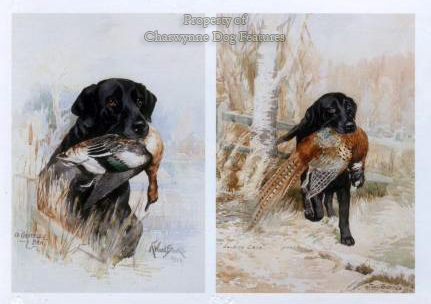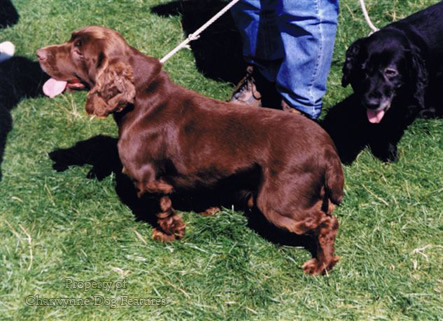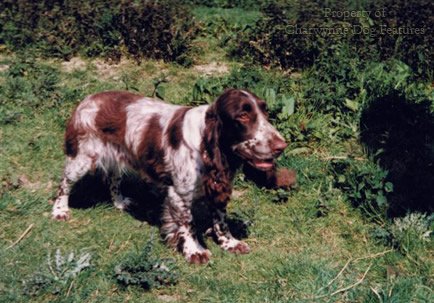251 Are Ped Gundogs Sound
ARE PEDIGREE GUNDOGS SOUND?
by David Hancock
 The division of most registered gundog breeds into a working type and a show variety is, however desirable to some and inevitable to others, to me regrettable. Some would claim that many working gundogs are just not handsome enough for the pet market, that the field trial dogs are too 'hot' even for rough shooters and that working ability in a showdog is wasted anyway, so why get excited about it? It has been argued that there are in fact three varieties within some gundog breeds: field trial, working test and show bench types. This may well be true in some retriever breeds and, after all, every working and sporting breed evolved in the pursuit of function. Foxhound breeders adapt their pack to their hunting country, so why shouldn't our gundog breeds just reflect the needs of their owners?
The division of most registered gundog breeds into a working type and a show variety is, however desirable to some and inevitable to others, to me regrettable. Some would claim that many working gundogs are just not handsome enough for the pet market, that the field trial dogs are too 'hot' even for rough shooters and that working ability in a showdog is wasted anyway, so why get excited about it? It has been argued that there are in fact three varieties within some gundog breeds: field trial, working test and show bench types. This may well be true in some retriever breeds and, after all, every working and sporting breed evolved in the pursuit of function. Foxhound breeders adapt their pack to their hunting country, so why shouldn't our gundog breeds just reflect the needs of their owners?
Sweeping generalisations are regularly made about the different varieties within a gundog breed, on the lines of, on the one hand that all show dogs have been ruined and, on the other, that all good working dogs are structurally sound. Yet we all know of some excellent dual-purpose gundogs and we all see dogs win in the field sometimes in spite of their anatomy. Strong working instincts are not automatically accompanied by a strong sound physique. But surely it would be good to see every dog in each gundog breed not only possessing working skills but also conforming to the breed standard. Handsome is as handsome does is no recipe for breeding better dogs.
This point is reinforced by my experience in recent years when judging gundog working tests. Three come particularly to mind. The first concerned a test at the admirable Gamekeepers' Fair held annually in April. This was a retriever test and involved some good working dogs, not all of whom typified their breed. One yellow Labrador had a head which would not have disgraced a foxhound. A whippety black Labrador really excelled whereas a handsome golden retriever just would not jump into the admittedly fast flowing river. A hard-eyed Chesapeake leapt a good ten feet out into the river without hesitating; but I later noted that it had poor movement, perhaps from upright shoulders and rather high hocks.
 The second involved a minor breeds spaniel working test -- and there wasn't an ugly dog there. But apart from Clive Rowlands' Rhiwlas field spaniels, there was hardly a dog with nose and hunting enthusiasm. The third, for curly-coated retrievers, and also on the estate that I used to manage, tested some extremely sound dogs but proved too much of a test for the handlers, who didn't always know enough to keep ahead of or even control their dogs. All this can be summarised as featuring: handsome dogs which couldn't work, dogs which worked very competently but would never win a beauty contest and owners/handlers who didn't know enough to coach whatever working instinct their dogs actually did have further forward. What can be done?
The second involved a minor breeds spaniel working test -- and there wasn't an ugly dog there. But apart from Clive Rowlands' Rhiwlas field spaniels, there was hardly a dog with nose and hunting enthusiasm. The third, for curly-coated retrievers, and also on the estate that I used to manage, tested some extremely sound dogs but proved too much of a test for the handlers, who didn't always know enough to keep ahead of or even control their dogs. All this can be summarised as featuring: handsome dogs which couldn't work, dogs which worked very competently but would never win a beauty contest and owners/handlers who didn't know enough to coach whatever working instinct their dogs actually did have further forward. What can be done?
Most sensible gundog men are full of admiration for show people who try to work their dogs. We all love a handsome dog; but a handsome useless dog has little value for me. As Wilson Stephens once memorably remarked on this subject: "They didn't send male models to recapture the Falklands." (As a one time member of 3 PARA, I know only too well that none of us were ever chosen for our looks!) Perhaps the ability of a gundog to carry the title of full champion in the show ring without a working certificate is itself creating a wider gap between show and working dogs.
Just as worrying and capable of causing more harm, is when a gundog wins in the show ring with serious anatomical faults for a functional animal. When conformation to a wholly physical blueprint, the breed standard, is the only criterion, it is vital for sound dogs to win. They get bred from the most. Yet a few years ago at Crufts, a pointer won not only its breed class but the whole gundog group with a pronounced Hackney action, a feature condemned in its own breed standard. This occurred under a famous judge who breeds well known retrievers. How long would such a pointer last on a grouse moor with such a defect? Surely the whole point when judging a gundog in the show ring is to consider whether its anatomy allows it to carry out its traditional field function. Otherwise it doesn't belong to that breed of gundog. Crufts winners are extensively bred from.
If this were an isolated case, it could be overlooked, but it is not. Here are some critiques from the judges themselves at shows in recent years: German wire-haired pointers at the 1996 Gundog Breeds Association of Scotland show: "In the last five years the breed has altered dramatically and not for the better I hasten to add. At least 50 per cent of the breed is incorrect to the standard and this has resulted in some poor quality dogs winning championship certificates." Labrador retrievers at the 1996 North West Labrador Club Championship Show: "The true Lab head and expression seems to have gone...Feet are distinctly odd at the moment throughout the breed...There can't have been more than about 20 bitches who were a suitable weight for a working breed...Coats surprised me no end...They gave an impression of density until you put your hand on them." German short-haired pointers at a 1996 show: "I was pleased to have 122 exhibits making 129 entries. The disappointment was the poor standard overall...They cannot perform the intended function in the field unless their construction is correct. They were after all bred for working."
Critical comments on the last named breed continued at the 1997 Manchester Championship show: "...very few of the exhibits before me at this event actually displayed any drive or satisfactory rear end movement." Other comments at 1996 shows included these words, on pointers: "Movement left a lot to be desired" and at a different show, with a record entry: "Are we becoming a breed of cardboard cut outs? ...it must look and act like a pointer, or we will lose the characteristics of the breed we love."; on Labradors: "What worried me ... was the continued deterioration in head quality...Movement was, as I expected variable." and at another show: "Front movement still needs our attention, this stems mainly from a short straight upper arm or upright shoulders."
Such worrying comments come from dog show judges who are so often accused of being too tolerant rather than hyper-critical. If the dogs drawing these comments are 'show quality', what is the quality like in those dogs sold by breeders to the pet market because they lack quality? If these dogs in the show critiques are representative of their particular breeds, what a commentary on pedigree dog breeders. There are clearly far too many people producing puppies for sale nowadays rather than breeding dogs. One hundred years ago, if a gundog was unable to perform in the field for any reason then it was culled. Today it would be bred from. This stems from a dog now being valued for what it looks like rather than for what it can do.
 Where do you advise the pet owner seeking a companion gundog to go for one? The Kennel Club advises us to go to a recognised specialist breeder. But every month in the Kennel Gazette, the KC publication, there are cases of breeders being banned for cruelty to their own dogs, cheating purchasers of puppies, falsifying hip scores, reneging on sale terms and otherwise acting discreditably. Unlike our ancestors who developed our splendid gundog breeds, we talk more proudly of a dog's pedigree, a piece of paper, than the dog. A Danish geneticist once went through his own country's dog breeding records and found that, on genetic grounds alone, 1 in 10 of the breeding records could not be correct. A recent test on registrations in the United States found that 13% were false. Our Kennel Club carries out no checks on the validity of its pedigrees -- just takes the registration fee!
Where do you advise the pet owner seeking a companion gundog to go for one? The Kennel Club advises us to go to a recognised specialist breeder. But every month in the Kennel Gazette, the KC publication, there are cases of breeders being banned for cruelty to their own dogs, cheating purchasers of puppies, falsifying hip scores, reneging on sale terms and otherwise acting discreditably. Unlike our ancestors who developed our splendid gundog breeds, we talk more proudly of a dog's pedigree, a piece of paper, than the dog. A Danish geneticist once went through his own country's dog breeding records and found that, on genetic grounds alone, 1 in 10 of the breeding records could not be correct. A recent test on registrations in the United States found that 13% were false. Our Kennel Club carries out no checks on the validity of its pedigrees -- just takes the registration fee!
Our forebears bred good dog to good dog and didn't regard purity of breeding as an over-riding factor. The setterman Laverack is on record as stating that a change of colour was as good as a change of blood. Would any setter breeder of today follow the master-breeder's advice? The great bloodhound breeder, Edwin Brough, advised an outcross every fifth generation. Would any bloodhound breeder of today follow such a respected pioneer breeder's advice? The best bred dogs in the United Kingdom are the foxhounds in the hunting packs and how often do they restrict their breeding to their own kennel or fail to use say Welsh foxhound blood when needed? Breeding animals is the single-minded pursuit of excellence not the blind pursuit of pure-breeding.
A sound gundog, whether a working dog or a pampered pet, should be not just anatomically able to function, but look and act like the breed it belongs to. I hate seeing Labradors with Rottweiler heads and the body of a fat whippet. I object to a pointer winning at Crufts with a Hackney action. I feel sad when I see a Gordon setter with no power in its back legs. I get cross when I see our famous native breeds bred to a harmful design. But far more serious than any of this is the breeding of dogs carrying defective genes, sometimes knowingly.
A study a few years ago by a group of distinguished Canadian veterinary surgeons concluded with these words: "The next hundred years look rather bleak for the pure-bred dog industry unless dramatic changes are introduced. We have a problem which if not addressed and speedily rectified, may destroy for all time many beautiful breeds of dog. All dog lovers share the blame for not acting..." They were referring to the practice of breeding dogs to a harmful design and to the failure to face the challenge posed by inheritable diseases. Our precious gundog breeds were handed down into our safekeeping by the likes of Laverack, Llewellin, Boughey, Lords Sefton, Derby, Knutsford and Malmesbury and the Dukes of Gordon, Kingston and Newcastle. What if they had tolerated unsound unhealthy dogs?
Would the Duke of Newcastle have tolerated spaniels at Clumber Park weighing 80lbs, with serious eye problems, whelping difficulties and 'slipping kneecaps'? If he had we would not have the breed of Clumber spaniel with us today. If we do then we are betraying a trust, the belief that we too would care for such dogs and perpetuate them in their own mould. Cocker spaniels can now inherit ectropian, entropian, a bleeding disorder known as factor X deficiency, progressive retinal atrophy, distichiasis and three different skeletal anomalies. How many mandatory control schemes have been set up to reduce their incidence? Not one.
Hip dysplasia is a crippling disease affecting a number of gundog breeds, especially Labradors and golden retrievers. Every year another 15,000 golden retrievers and 30,000 Labs are registered with the Kennel Club. They come from breeding stock only a tiny number of which has been hip scored. Who knows what their hips will be like? Why shouldn't their purchasers get their money back if these pups develop hip dysplasia in due course? Most of them will be too distressed by their dog's suffering to even try.
The literally cruel fact is that nobody cares enough to lobby for compulsory clearances for all pedigree breeding stock. This does nothing for subject creatures in our care. It does nothing to perpetuate pedigree dogs as sound healthy animals for working use or as companion dogs. We should be thoroughly ashamed of the way we breed our gundogs and even more ashamed by our total failure to safeguard their health and well-being. We are a nation of dog-owners not dog-lovers. We have lost our way. There is a way back; but it is conscience-led not wallet-led. What are you, the reader, now going to do about this shameful state of affairs? You, in your own name. It's going to take action by us all to put this right, and we'll be better people for the trying.
"In magnis et voluisse sat est..."